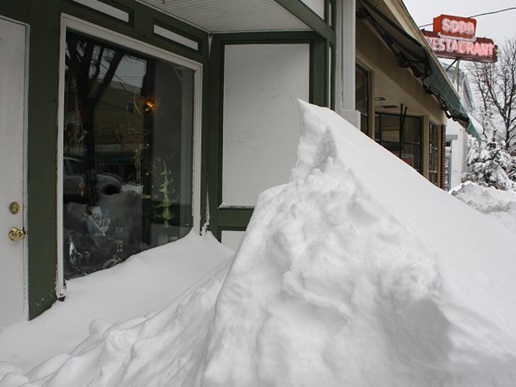PRINT AS PDF
Last week’s blizzard narrowly missed bringing the New York City Metropolitan Area a near-historic snowfall. Instead, 24”-30” of snow fell across Suffolk County into New England while the City received a relatively modest 9.8”. As a result, Lehman College reopened on schedule for the start of spring classes on Wednesday.

What might have been (Greenport, New York)
While many students have already begun to dig into their studies and perhaps a few have now turned to the Groundhog hoping for six more weeks of winter (as close to a sure bet as there can be given the computer projections) and a chance for another snow day, instructors are focused on the student learning experience.
To measure student learning in my BBA 407 Strategic Management course, I give students a diagnostic exam on their first day of class. This exam allows me to assess where students stand in terms of knowledge at the beginning of the semester and then estimate how much they expanded that knowledge at the end of the course.
Their performance on this exam is used to create a measure of student learning potential. Basically, student learning potential is the material and concepts with which students are not familiar at the start of the semester.
At the end of the semester, students are again tested on the concepts covered in the diagnostic exam. Afterward, the results are compared with those on the diagnostic exam. Those comparative outcomes make it possible to determine how much of the student learning potential was actually realized and where.
For example, let’s say a hypothetical class has a mean score of 40% on the diagnostic exam. Those hypothetical results would imply that students are unfamiliar with 60% of the course content. That 60% figure is student learning potential.
At the end of the semester, let’s say, those same students have a mean score of 80% on the concepts covered in the diagnostic exam. That would mean the class registered an average gain of 40 percentage points. That increase would cover two-thirds of the student learning potential, indicating that students learned two-thirds of the material with which they were unfamiliar at the start of the semester.
The benefit of such an approach is that the measure of realized student learning potential is standardized. It takes into consideration the differences in knowledge and ability of incoming classes, something that course averages or final exam scores do not.
Since I’ve been administering the diagnostic exams, realized student learning potential has ranged from 55.9% to 61.5%. The high figure was achieved last semester when extra material and instruction was provided on select course concepts. Those concepts were identified from past exams and covered areas in which past classes consistently had difficulty. This semester, the same degree of attention and material will be provided to see if the gain in those concept areas can be sustained.
The quest to maximize student learning is a never-ending one. Measuring student learning and better understanding approaches, methods, and materials that enhance student learning are critical. The diagnostic exam is one tool that can help make it possible to improve student learning outcomes.


